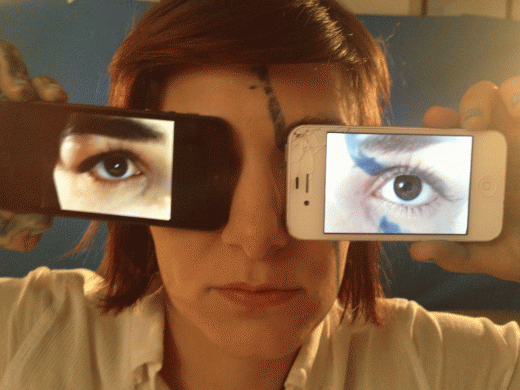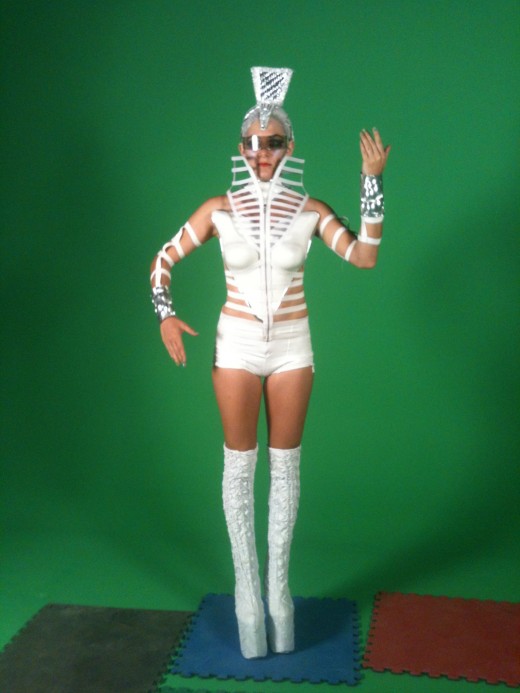
Jillian Mayer and Lucas Leyva, “#PostModem,” 2012. Video, 13 minutes, color. Photos courtesy of the David Castillo Gallery.
Before Mayer was showing off her trademark smirk on video bios for the Guggenheim, the Miami native competed as a breakdancer under the name Yoma for five years, earned a BFA at Florida International University, and married her Chihuahua, Shivers, during a performance at the Adrienne Arsht Center’s Here and Now Festival. She has modeled clothing and lingerie and is often adorned by print-happy dresses as sprightly as her films’ art direction. And perhaps predictably, her Gchat etiquette is flawless, down to the emoticon.
It’s a reflection of Mayer’s adeptness at messaging. And like a marketer, she has several tools at her disposal, including shock value. See: “I Am Your Grandma” (2011), a disturbing vlog-style video that garnered millions of YouTube views and viral street cred. In it, Mayer plays the grotesque grandmother of her future grandchildren, which among other things questions the motivators behind over-sharing personal details on social media sites—like, say, grieving on Facebook.
Mayer’s deeper foray into postmodernism is marked by subversions of the human experience. Take the nauseating “Giving Birth to Myself” (2011), which along with “Grandma” was featured in her Family Matters solo show at the David Castillo Gallery. “Birth” depicts a sweat-drenched Mayer doing precisely what the title implies, birthing herself as a phlegm-green infant. “‘Giving Birth to Myself’ wasn’t about separating life stages, but the opposite,” said Mayer. “It is about combining them as one metanarrative. The creator becomes the object, identities merge and it’s presentational.” The result is an event that strikes both pleasure and anxiety in the viewer, inducing a sensation Kant described as “mathematically sublime.”
Around this time, she and frequent collaborator Lucas Leyva (founder of the Borscht Film Festival) rose to national prominence with the Sundance screening of “The Life and Freaky Times of Uncle Luke,” (2012) whose acclaim placed the duo at the forefront of a nascent Miami film scene. The film, a “modern Miami adaptation” of Chris Marker’s 1962 La Jetée, is a meditation on love, time travel and finality that features 2 Live Crew’s Luther Campbell as the last man in a post-nuclear Miami. Its look, which Mayer calls “easily approachable through attainable or inviting colorful aesthetics,” landed the duo a venerable spot in Filmmaker Magazine’s “25 New Faces of Independent Film.”
The Mayer/Leyva blitz was capped off when a barrage of “Lukey” cushions designed by Gabriel Alcala of Jacuzzi Boys invaded Park City. And while on the subject, Mayer’s favorite Uncle Luke song is “It’s Your Birthday” and she’s an admittedly awkward booty dancer. She may have even been chronic cassette un-pauser type. She does remember a time when Miami was more rave, however, and “wasn’t even aware of the art scene when I was in my late teens, but now I live in it.”
Mayer admits that while her environment can be influential, her work is mostly independent of any particular GPS coordinate. Connecting via the Internet is really the key for Mayer, who is thankful for not experiencing social media until her 20s, allowing her to explore its seismic shifts like a double agent. But however fascinated she may seem, Mayer isn’t the reSTART or other Internet addict program type—she logs out at the slightest throbbing of the eyes and excessive online time depresses her. So it’s telling that, when asked about our very American obsession with benzodiazepines and other such medication, she replies with a simple command from a recent project: “reclaim your life again.”
“EraseyPage.com” (2012) is a faux web page and collaborative video project that leads users to liberate themselves by fictitiously erasing the Internet, one website at a time. It’s an exercise in parsing out irrelevance and sensory overload akin to choosing clothes for a Goodwill drop. And while the project’s overall tone is jovial, there’s still something deeply unnerving about even having a digital identity to proactively manage. The Internet is a judgmental realm where a person’s future, as Mayer puts it, “can be slighted by repercussions from their actions or exploitation of self.
Mayer further explores such motifs with #PostModem (2012), another Mayer/Leyva collaboration screening at Sundance. This time around, they’ve planned to give away spiritual regalia like dream catchers and pencils engraved with cryptic phrases which remind audience members of their own mortality. But despite the somewhat gloomy souvenirs, it’s all in good spirit. The duo dubs the effort a “comedic satirical sci-fi pop-musical,” perhaps the only compound-genre name apt to label a film based largely on transhumanist theory.

Jillian Mayer and Lucas Leyva, “#PostModem,” 2012. Video, 13 minutes, color. Photos courtesy of the David Castillo Gallery.
Their jaunt through metapop sing-alongs and cinematic tweets culminates in Mayer’s nude baptism scene, where she dons a roaring jetpack. Her eventual descent reflects euphoria’s tragic, temporal crux, and signals the sinusoidal ups and downs that permeate the film. When asked about the nudity, Mayer maintains a focus on impermanence, remarking “being naked is funny and I wish I lived somewhere where people cared less and shame wasn’t engrained in our heads. We will only have these bodies for a short amount of time and every few years they change. I look at it as an archive of what my form once was.”
Mayer’s work is a hobnob between the New Aesthetic movement and an inimitable hyperreal gusto, pilfering imagery from the Internet and the IRL world. It’s often daunting—her process means datamoshing cultural memes and readying them for a full cognitive digestive cycle, often born from an angst that feels suburban in nature. But despite her efforts to maintain a consistent oeuvre, Mayer isn’t entirely convinced there is a place for art in the anomalous “future future.”
Perhaps she means art qua art, in the way Marxist writer August Bebel would’ve described the multifaceted craftsmen of the future as propelled by intrinsic motivators beyond the visage of professionalism. Or perhaps there’s a reference to foreseeable advancements in machine learning and other forms of artificial intelligence that’ll reduce aesthetics down to precisely executed algorithms, leaving said AI to experiment with ways of expressing humankind’s more indecipherable truths. Or maybe the democratization of resources will reduce art to something more prosaic. Mayer points out “creatives can exist anywhere they have an Internet connection.” So what would Jillian Mayer do in the future, if not art?
“Quality control,” she said bluntly.










